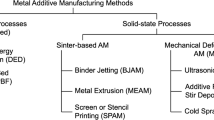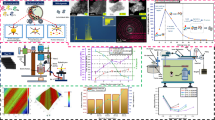Abstract
Zinc oxide is densified to 97% by the cold sintering process using an aqueous zinc acetate solution as the secondary transport phase. The mechanical response of the cold-sintered zinc oxide ceramics is investigated through the ball-on-three-balls biaxial bending technique. The analysis demonstrates that ZnO cold-sintered samples follow a Weibull distribution with a characteristic strength (σ0 ~ 65 MPa) and Weibull modulus (m ~ 8). Phase purity and residual secondary phases were analyzed via X-ray diffraction and Raman spectroscopy. This report provides an initial demonstration of the mechanical properties of cold-sintered parts in the as-pressed and unmodified state and serves for comparison with conventionally prepared ceramics.




Similar content being viewed by others
References
Maria JP, Kang X, Floyd RD et al (2017) Cold sintering: current status and prospects. J Mater Res 32:3205–3218
Gonzalez-Julian J, Neuhaus K, Bernemann M et al (2018) Unveiling the mechanisms of cold sintering of ZnO at 250 °C by varying applied stress and characterizing grain boundaries by Kelvin Probe Force Microscopy. Acta Mater 144:116–128
Funahashi S, Guo J, Guo H et al (2017) Demonstration of the cold sintering process study for the densification and grain growth of ZnO ceramics. J Am Ceram Soc 100:546–553
Kang X, Floyd R, Lowum S et al (2018) Mechanism studies of hydrothermal cold sintering of zinc oxide at near room temperature. Manuscript submitted for publication
Börger A, Supancic P, Danzer R (2002) The ball on three balls test for strength testing of brittle discs: stress distribution in the disc. J Eur Ceram Soc 22:1425–1436
Yoshimura HN, Molisani AL, Narita NE et al (2006) Mechanical properties and microstructure of zinc oxide varistor ceramics. Mater Sci Forum 530–531:408–413
European Committee for Standardization (1996) EN 843-5: advanced technical ceramics—monolithic ceramics—mechanical tests at room temperature—part 5: statistical analysis. European Committee for Standardization, Brussels
Balzer B, Hagemeister M, Kocher P, Gauckler LJ (2004) Mechanical strength and microstructure of zinc oxide varistor ceramics. J Am Ceram Soc 87:1932–1938
Lu C, Danzer R, Fischer FD (2004) Scaling of fracture strength in ZnO: effects of pore/grain-size interaction and porosity. J Eur Ceram Soc 24:3643–3651
Cuscó R, Alarcón-Lladó E, Ibáñez J et al (2007) Temperature dependence of Raman scattering in ZnO. Phys Rev B 75:165202-1–165202-11
Ben Yahia S, Znaidi L, Kanaev A, Petitet JP (2008) Raman study of oriented ZnO thin films deposited by sol-gel method. Spectrochim Acta Part A Mol Biomol Spectrosc 71:1234–1238
Yang MM, Crerar DA, Irish DE (1989) A Raman spectroscopic study of lead and zinc acetate complexes in hydrothermal solutions. Geochim Cosmochim Acta 53:319–326
Johnson MK, Powell DB, Cannon RD (1981) Vibrational spectra of carboxylato complexes-I. Infrared and Raman spectra of beryllium(II) acetate and formate and of zinc(II) acetate and zinc(II) acetate dihydrate. Spectrochim Acta 37A:899–904
Acknowledgements
The authors would like to thank members of the Pennsylvania State University for the use of their equipment including Alexander Wilson-Heid and Professor Allison Beese, the Huck Institutes of the Life Sciences’ Microscopy and Cytometry Facility, and the Materials Characterization Lab’s Raman Facility. This material is based upon work supported by the National Science Foundation, as part of the Center for Dielectrics and Piezoelectrics under Grant Nos. IIP-1361571 and 1361503. This material is based upon work supported by the National Science Foundation Graduate Research Fellowship Program under Grant No. DGE-1252376. Any opinions, findings, and conclusions or recommendations expressed in this material are those of the author(s) and do not necessarily reflect the views of the National Science Foundation.
Author information
Authors and Affiliations
Corresponding author
Ethics declarations
Conflicts of interest
The authors declare that they have no conflict of interest.
Rights and permissions
About this article
Cite this article
Lowum, S., Floyd, R., Bermejo, R. et al. Mechanical strength of cold-sintered zinc oxide under biaxial bending. J Mater Sci 54, 4518–4522 (2019). https://doi.org/10.1007/s10853-018-3173-8
Received:
Accepted:
Published:
Issue Date:
DOI: https://doi.org/10.1007/s10853-018-3173-8




